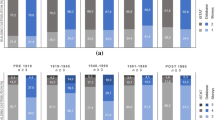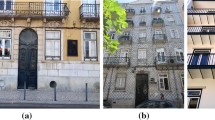Abstract
Many historic buildings in old urban centers in Eastern Canada are made of stone masonry reputed to be highly vulnerable to seismic loads. Seismic risk assessment of stone masonry buildings is therefore the first step in the risk mitigation process to provide adequate planning for retrofit and preservation of historical urban centers. This paper focuses on development of analytical displacement-based fragility curves reflecting the characteristics of existing stone masonry buildings in Eastern Canada. The old historic center of Quebec City has been selected as a typical study area. The standard fragility analysis combines the inelastic spectral displacement, a structure-dependent earthquake intensity measure, and the building damage state correlated to the induced building displacement. The proposed procedure consists of a three-step development process: (1) mechanics-based capacity model, (2) displacement-based damage model and (3) seismic demand model. The damage estimation for a uniform hazard scenario of 2% in 50 years probability of exceedance indicates that slight to moderate damage is the most probable damage experienced by these stone masonry buildings. Comparison is also made with fragility curves implicit in the seismic risk assessment tools Hazus and ELER. Hazus shows the highest probability of the occurrence of no to slight damage, whereas the highest probability of extensive and complete damage is predicted with ELER. This comparison shows the importance of the development of fragility curves specific to the generic construction characteristics in the study area and emphasizes the need for critical use of regional risk assessment tools and generated results.
Similar content being viewed by others
References
Abo-El-Ezz A, Nollet MJ and Nastev M (2011), “Analytical Displacement-based Seismic Fragility Analysis of Stone Masonry Buildings,” Proceedings of the 3rd International Conference on Computational Methods in Structural Dynamics and Earthquake Engineering, Corfu, Greece.
Adams J and Halchuk S (2003), “Fourth Generation Seismic Hazard Maps of Canada: Values for Over 650 Canadian Localities Intended for the 2005 National Building Code of Canada,” Open File No. 4459, Geological Survey of Canada, Ottawa, Canada.
Barron-Corverra R (2000), “Spectral Evaluation of Seismic Fragility in Structures,” PhD Dissertation, University at Buffalo, The State University of New York, Buffalo, USA.
Borzi B, Crowley H and Pinho R (2008), “Simplified Pushover-based Earthquake Loss Assessment (SPBELA) Method for Masonry Buildings,” International Journal of Architectural Heritage, 2(4): 353–376.
Bosiljkov V, Page A, Bosiljkov B and Žarnić R (2010), “Evaluation of the Seismic Performance of Brick Masonry Walls,” Structural Control and Health Monitoring, 17(1): 100–118.
Calvi GM (1999), “A Displacement-based Approach for Vulnerability Evaluation of Classes of Buildings,” Journal of Earthquake Engineering, 3(3): 411–438.
Chidiac SE, Foo S and Cheung MS (2000), “Seismic Guidelines for Stone-masonry Components and Structures,” Proceedings of the International Conference on the Seismic Performance of Traditional Buildings, Turkey.
Choun YS and Elnashai AS (2010), “A Simplified Framework for Probabilistic Earthquake Loss Estimation,” Probabilistic Engineering Mechanics, 25(4): 355–364.
Coburn A and Spence R (2002), Earthquake Protection, 2nd Edition, J. Wiley, Chichester, England.
Elmenshawi AE, Sorour M, Mufti A, Jaeger L and Shrive, N (2010), “In-plane Seismic Behaviour of Historic Stone Masonry,” Canadian Journal of Civil Engineering, 37(3): 465–476.
Erberik MA (2008), “Generation of Fragility Curves for Turkish Masonry Buildings Considering In-plane Failure Modes,” Earthquake Engineering and Structural Dynamics, 37(3): 387–405.
Erberik MA and Elnashai AS (2004), “Fragility Analysis of Flat-slab Structures,” Engineering Structures, 26(7): 937–948.
Erdik M, Sesetyan K, Demircioglu M, Hancilar U, Zulfikar C, Cakti E and Cagnan Z (2010), “Rapid Earthquake Hazard and Loss Assessment for Euro-Mediterranean Region,” Acta Geophysica, 58(1): 855–892.
Fajfar P (2000), “A Nonlinear Analysis Method for Performance-based Seismic Design,” Earthquake Spectra, 16(3): 573–592.
FEMA (2003), “HAZUS-MH MR4: Multi-hazard Loss Estimation Methodology Earthquake Model,” Technical Manual, Federal Emergency Management Agency, National Institute of Building Science, Washington, D.C, USA.
FEMA (2005), “Improvement of Nonlinear Static Seismic Analysis Procedures,” Report Number 440, Federal Emergency Management Agency, Applied Technology Council, Washington D.C., USA.
Frankie T (2010), “Simulation-based Fragility Relationships for Unreinforced Masonry Buildings”, MSc Dissertation, University of Illinois at Urbana Champaign, USA.
Gencturk B, Elnashai AS and Song J (2008), “Fragility Relationships for Populations of Woodframe Structures Based on Inelastic Response,” Journal of Earthquake Engineering, 12(2), 119–128.
Giovinazzi S (2005), “The Vulnerability Assessment and the Damage Scenario in Seismic Risk Analysis”, PhD Dissertation, University of Florence, Italy and Technical University of Braunschweig, Germany.
Jeong SH and Elnashai AS (2007), “Probabilistic Fragility Analysis Parameterized by Fundamental Response Quantities,” Engineering Structures, 29(6): 1238–1251.
Kircher CA, Nassar AA, Kustu O and Holmes WT (1997), “Development of Building Damage Functions for Earthquake Loss Estimation,” Earthquake Spectra, 13(4): 663–682.
Lang K (2002), “Seismic Vulnerability of Existing Buildings,” PhD Dissertation, Swiss Federal Institute of Technology, Zurich, Switzerland.
Lefebvre K (2004), “Caracterisation Structurale et Evaluation de la Vulnerabilite Sismique des Batiments Historiques en Maconnerie du Vieux-Montreal», MSc Dissertation, Ecole de Technologie Superieure, Montreal, Canada.
Magenes G and Calvi GM (1997), “In-plane Seismic Response of Brick Masonry Walls,” Earthquake Engineering and Structural Dynamics, 26(11): 1091–1112.
Mazzon N (2010), “Influence of Grout Injection on the Dynamic Behaviour of Stone Masonry Buildings,” PhD Dissertation, University of Padova, Italy.
Park J, Towashiraporn P, Craig JI and Goodno BJ (2009), “Seismic Fragility Analysis of Low-rise Unreinforced Masonry Structures,” Engineering Structures, 31(1): 125–137.
Restrepo-Vélez LF (2003), “A Simplified Mechanicsbased Procedure for the Seismic Risk Assessment of Unreinforced Masonry Buildings,” Individual Study, European School for Advanced Studies in Reduction of Seismic Risk, University of Pavia, Italy.
Rota M, Penna A and Magenes G (2010), “A Methodology for Deriving Analytical Fragility Curves for Masonry Buildings Based on Stochastic Nonlinear Analyses,” Engineering Structures, 32(5): 1312–1323.
Ruiz-García J and Miranda E (2007), “Probabilistic Estimation of Maximum Inelastic Displacement Demands for Performance-based Design,” Earthquake Engineering and Structural Dynamics, 36(9): 1235–1254.
Ruiz-García J and Negrete M (2009), “Drift-based Fragility Assessment of Confined Masonry Walls in Seismic Regions,” Engineering Structures, 31(1): 125–137.
TomaŽevič M (1999), Earthquake-Resistant Design of Masonry Buildings, Innovation in Structures and Construction, Vol. 1, Imperial College Press, London, UK.
Tomaževič M and Lutman M (2007), “Heritage Masonry Buildings in Urban Settlements and the Requirements of Eurocodes: Experience of Slovenia,” International Journal of Architectural Heritage, 1(1): 108–130.
TomaŽevič M and Weiss P (2010), “Displacement Capacity of Masonry Buildings as a Basis for the Assessment of Behavior Factor: an Experimental Study,” Bulletin of Earthquake Engineering, 8(6): 1267–1294.
Turnšek V and Čačovič F (1971), “Some Experimental Results on the Strength of Brick-masonry Walls”, Proceedings of the 2nd International Brick-masonry Conference, Stoke-on-Trent, UK, pp.149–156.
Vallieres A (1999), “Processus de Transformation Typologique du bâti Résidentiel dans l’arrondissement Historique du Vieux-Québec,” MSc Dissertation, Laval University.
Vasconcelos G (2005), “Experimental Investigations on the Mechanics of Stone Masonry: Characterization of Granites and Behaviour of Ancient Masonry Shear Walls,” PhD Dissertation, University of Minho, Portugal.
Author information
Authors and Affiliations
Corresponding author
Additional information
Supported by: Natural Resources Canada — Geological Survey of Canada Public Safety Geoscience Program, and the Chemical, Biological, Radiological-Nuclear and Explosives Research and Technology Initiative, administered by the Defence R&D Canada — Centre for Security Science
Rights and permissions
About this article
Cite this article
Abo-El-Ezz, A., Nollet, MJ. & Nastev, M. Seismic fragility assessment of low-rise stone masonry buildings. Earthq. Eng. Eng. Vib. 12, 87–97 (2013). https://doi.org/10.1007/s11803-013-0154-4
Received:
Accepted:
Published:
Issue Date:
DOI: https://doi.org/10.1007/s11803-013-0154-4




